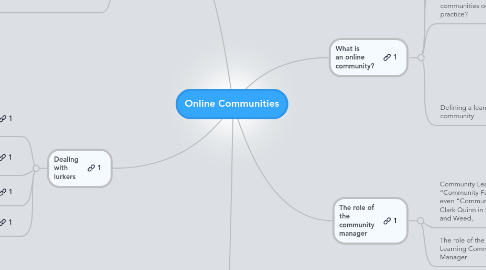Online Communities
Door Phillip McCreight


1. Five tips for keeping your online community buzzing
1.1. Provide daily input – Don’t underestimate the amount of time and work that will go into nurturing and feeding an online community. This might require daily postings of different kinds to stimulate responses and engagement. It might be simply to share a link or to ask a question or even start a debate about a controversial topic. It might just be watching and responding. Use a variety of ideas to inject new ideas - Ian Wooler provides 10 ideas and tips to help sustain interest and promote discussion.
1.2. Involve senior leaders - Some organisational communities might benefit from the presence of the senior leaders with them. A review of the Yammer network at Deckers Outdoor corporation recommends this approach.
1.3. Centralize your community around events - Think about how you can use your community in your face-to-face events – these may be networking events or even formal training sessions – or your virtual events. Jeremiah Owyang has written a good article about this: How to integrate social technologies with virtual events. Even use it to host a live event: In the Yammer world, such an activity is called a “YamJam”. Austen Hunter, Head of Transport Operations at Brighton & Hove City Council (BHCC) wrote a blog post on how he set up a YamJam.
1.4. Reward participation – One approach that is often used to stimulate participation and engagement is to reward participation in the community. Interact Intranet promotes this approach in 53 ways to boost collaboration on your intranet,
2. Dealing with lurkers
2.1. Participation Inequality: Encouraging More Users to Contribute
2.2. Is the 90-9-1 Rule for Online Community Engagement Dead?
2.3. Lurking islearning (Part 1 of 2),
2.4. Lurking isLearning (Part 2 of 2),
3. Activity
3.1. 1 – Think about some of the groups, communities and networks you have participated in? What have you liked (and/or not liked) about them? What do you think were the factors that made them work (or not) for you? Share your thoughts with the rest of the group
3.2. 2 - Are you a Community Manager? Share your typical daily activities with the rest of the group.
3.3. 3 – Have you been responsible for the setting up of a learning community or community of practice? Please describe its features and functionality to the rest of the group and/or show it to us in the Virtual Coffee session.
3.4. 4 – The topic of lurking in a community always arouses a lot of passion! What are your views on lurkers and how do you think they can be best encouraged to participate in a community?
4. What is an online community?
4.1. Community vs Social Network
4.2. different Types of Communities.
4.3. What are communities of practice?
4.4. Defining a learning community
4.4.1. a classroom or course community - be it face-to-face or online
4.4.2. a professional learning community (ie individuals from the same profession or industry who have come together for the express purpose of learning from one another)
4.4.3. a community set up by private training company or other organisation that offers educational opportunities or training to external participants
4.4.4. an enterprise learning community that fosters and supports learning (both formal and informal) across the organisations
